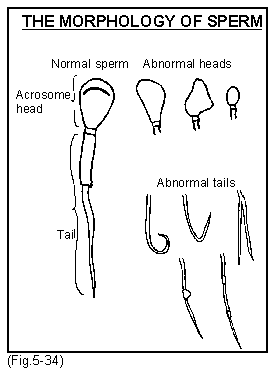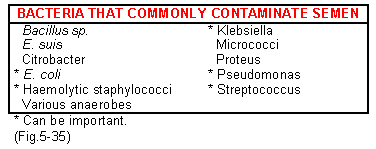



Facts about semen
Some important bacterial diseases can be spread in semen during service, notably brucellosis and leptospirosis.- Volume – 50-400 ml, mean 250ml.
- Colour – creamy white
- A good ejaculate is very milky.
- The ejaculate becomes watery if the boar is overused. If used am/pm/am the last ejaculate will be poor.
- Temperature of sperm. 37.5ºC (100ºF)
- In hot weather >30ºC (86ºF) sperm quality is affected.
- Sperm production. This takes up to 6 weeks. High temperatures such as fevers will affect sperm production for this length of time and potentially affect fertility.
- Numbers of sperm per ml, up to 100 million.
- Sperm production time:
- Up to 4 weeks of development in the testes and 2 weeks maturing in the epididymis.
- 5-20 minutes for complete ejaculation.
- Sperm remains viable in the sow for 30-48 hours
- The structure and shapes of normal and abnormal sperm are shown in Fig.5-34.

Sperm consists of a head and a tail. The head has a cap or acrosome which assists it to penetrate the egg. It appears normally as a crescent shape. The tail gives the sperm mobility to penetrate the egg and thus any abnormalities will decrease the possibility of penetration. Non mobile sperm are incapable of fertilisation.
As sperm matures a small droplet - the cytoplasmic droplet - is produced just beneath the attachment of the tail to the head. However, once maturity has been reached it disappears and therefore if semen contains high numbers of sperm with droplets, fertility will be poor and it is probable that the boar is being over used. If a sample of semen is examined whilst warm under a microscope sperm appear swirling in waves. This is an indication of good viability.
Bacteria and infectious agents
Semen in the epididymis normally does not contain any bacteria or virus but during ejaculation contaminants from the prepucial sac and elsewhere can cause high numbers to be present. (Fig.5-35). Semen samples usually contain at least 100 bacteria per ml and often many more. It is common practice to add antibiotics to semen samples used for AI. These kill or incapacitate many of the bacteria but they have no effect on viruses.
At a practical level semen is not usually a cause of disease spread, nevertheless the following viral diseases may be present, particularly if the boar is ill or at the early acute stage of infection at the time of collection.
- Aujeszky's disease virus.
- Cytomegalo virus.
- Foot-and-mouth disease virus.
- Genital papilloma virus.
- Parvovirus.
- PRRS virus.
- Swine fever (HC) virus.
- Swine vesicular disease virus.
- TGE virus
- Influenza virus.
Many other viruses have been detected in semen but their significance is not known. Some important bacterial diseases can also be spread in semen during service, notably brucellosis and leptospirosis.







